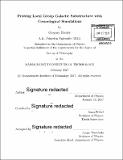Probing local group galactic substructure with cosmological simulations
Author(s)
Dooley, Gregory (Gregory Alan)
DownloadFull printable version (39.76Mb)
Other Contributors
Massachusetts Institute of Technology. Department of Physics.
Advisor
Anna Frebel.
Terms of use
Metadata
Show full item recordAbstract
The Lambda cold dark matter (ACDM) model is enormously successful at predicting large scale structure in the Universe. However, some tensions still remain on small scales, specifically regarding observed satellites of the Milky Way (MW) and Andromeda. Foremost among the problems have been the missing satellite, too big to fail, and cusp/core problems, which concern the expected abundance of satellites and their inner structure. This Ph.D. thesis consists of a series of studies using dark matter only cosmological N-body simulations of MW-mass galaxies to address topics related to these issues. In light of the recent Planck mission, I investigate how changes to cosmological parameters affect dark matter halo substructure. I find that the process of continuous sub-halo accretion and destruction leads to a steady state description of most subhalo properties in a given host, unchanged by small fluctuations in cosmological parameters. Subhalo concentration, maximum circular velocity, and formation times, however, are somewhat affected. One way to reduce the central density of satellites, as needed to solve the cusp/core and too big to fail problems, is through self-interacting dark matter (SIDM). I search for new implications of SIDM and find that stars in satellites spread out to larger radii and are tidally stripped at a higher rate in SIDM than CDM, even though the mass loss rate of dark matter is unchanged. These signatures should be particularly prominent in ultrafaint dwarf galaxies for the class of otherwise difficult to constrain velocity-dependent SIDM models. I also helped carry out the Caterpillar project, a suite of 36 high mass resolution (~ 10' Mo/particle) simulations of MW-like galaxies used to study diversity in halo substructure. To these, I apply abundance matching and reionization models to make novel predictions about the abundance of satellites in isolated dwarf galaxies out to 8 Mpc to help guide future searches. Applying the same techniques to predict satellites within 50 kpc of the LMC, I discover large discrepancies with the observed stellar mass function, which may lead to new constraints on the galaxy stellar mass-halo mass relationship, and the ability of reionization to leave dark matter halos entirely dark.
Description
Thesis: Ph. D., Massachusetts Institute of Technology, Department of Physics, 2017. Cataloged from PDF version of thesis. Includes bibliographical references (pages 315-358).
Date issued
2017Department
Massachusetts Institute of Technology. Department of PhysicsPublisher
Massachusetts Institute of Technology
Keywords
Physics.